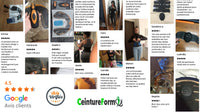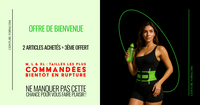Restraint Belt
Instantly relieve your lower back pain and provide lasting protection for your back with our simple, ultra-effective professional support belt.
Why choose this support belt?
-
Instant relief and pain prevention : It keeps your back straight, reduces pressure on the spine and soothes your pain from the first use.
-
Optimal comfort and freedom of movement : its ergonomic design adapts to all body shapes without hindering your daily movements.
-
Easy to use and adjust : thanks to its reinforced Velcro straps, you can install it in less than 30 seconds without any help.
Are you tired of living with pain? Here is finally the solution that will effectively relieve you.
Let's be honest... If you're here, it's because your back is giving you pain. Lower back pain, sciatica, poor posture, or simple muscle fatigue: whatever the cause, the pain is there, and it's ruining your life.
Every day, getting up, walking, carrying groceries, sitting, or standing for long periods of time becomes a challenge. You may have already tried miracle cures or other belts without any real results.
But the truth is simple: it's not just about support, it's about good fit , smart weight distribution and freedom of movement .
This is exactly what our Professional Support Belt brings to you.
A support belt designed to relieve and protect, not to constrain
Unlike many low-end models that compress too much or hinder your movements, our belt was designed with the recommendations of health professionals.
✔ Its ideal height effectively covers the lumbar and abdominal area to provide optimal support.
✔ Its elastic side strap system allows you to adjust the splint according to your needs, without ever tightening too much or restricting your movements.
✔ You can wear it comfortably between 5 and 9 hours a day , while maintaining the mobility necessary for your daily activities.
And when evening comes? Simply remove it to let your muscles breathe naturally, as physiotherapists advise. There's no risk of weakening your back if you follow these best practices.
An ultra-simple medical device to use that makes a difference from the first minutes
Putting on your belt is child's play: position it at the bottom of your back, fold down the two front sections, then adjust the elastic straps for a fit perfectly suited to your body shape.
You won't need anyone to help you. In less than 30 seconds, your belt is installed and you'll already feel relief.
It's not just a simple accessory, it's a real rehabilitation tool that accompanies you in your daily life: at work, at home or even during your moderate activities.
Its breathable and anti-perspirant design guarantees you optimal comfort all day long, even in summer.
Professional quality recommended for relief and prevention
Make no mistake, this belt is the choice of discerning individuals. Those who don't want a cheap gadget, but a genuine medical product built to last.
It is suitable for both men and women thanks to its unisex cut and universal adjustment system.
Whether you suffer from chronic lower back pain, temporary tension, or simply want to prevent future pain, this belt is for you.
Even today, many health professionals recommend it for back rehabilitation, injury prevention and relief of everyday pain.
✅ In summary, here's why you'll love this support belt:
-
Immediate relief from lower back pain and improved posture from the first use.
-
Easy and quick to install alone thanks to its adjustable Velcro straps.
-
Optimal comfort all day long, without hindering your movements.
-
Suitable for all body types, men or women.
-
Professionally recommended medical product with excellent value for money.
We are committed to providing an exceptional shopping experience to our customers. That's why we offer free shipping on all our orders, with no minimum purchase required .
Your order will be carefully packed and shipped within 24-48 hours. This way you can enjoy your favorite items at no extra cost and within a reasonable time frame .
A tracking tool for your package is available on our site, you just have to click on "track my order" at the bottom of the page. At the same time you will receive an email notifying you of the shipment.
From our distribution center in the Paris region, orders placed before 2 p.m. are shipped the same day, except weekends and public holidays. After that, they leave the next day.
🇫🇷 In mainland France, standard delivery takes approximately 7 to 10 days.
For other countries, express shipments take 2 to 6 days and delivery times will vary depending on the carrier.
 |
On average, we ship orders within 24 to 48 hours . |
 |
You have 30 days to return the item to us after receipt. |
At Ceinture Form, customer satisfaction is our top priority. We are proud to have over 60,000 satisfied customers who have chosen to trust us with their purchases.
Thanks to our commitment to quality and service, our store has received an exceptional average rating of 4.7/5 , reflecting the level of satisfaction of our customers.
Our goal is to provide you with a pleasant and hassle-free shopping experience , providing you with quality products and attentive customer service. Join our community of happy customers and find out why they rated us so highly.

1) Exclusive reduction: Use the promo code TOP5 to benefit from €5 off your purchase. Take advantage of this exceptional offer valid today only to treat yourself to our innovative and high-performance belts.
2) Commit to your well-being: By choosing Ceinture Form, you are making a consistent choice and committing to your health and well-being. Our products are designed by a team of experts in the field of health and sport to meet your specific needs.
3) As many orders placed as satisfied customers: Join the 60,000 satisfied customers who have given us an average rating of 4.7/5. This excellent evaluation testifies to the quality of our products and our after-sales service in French.
4) Trademark registered with the INPI: Ceinture Form is a registered trademark, representing a French company specializing in abdominal and lumbar belts. Trust our expertise and commitment to excellence.
5) We make the difference: Our products are designed to meet the specific needs of our customers, which makes them unique and sought-after. Don't wait to take advantage of our revolutionary and effective belts, as our stocks are limited.
6) Free delivery: By ordering from Ceinture Form, you benefit from free secure delivery, allowing you to benefit from our products at no additional cost.
7) Exclusive gifts: If you finalize your order in less than 20 minutes, we offer you a digital guide worth €4.90:
- Slim down with pleasure while remaining toned: the best seller!

Order now! Use the promo code TOP5 to benefit from €5 off your purchase and find out why our customers give us such a good rating.















